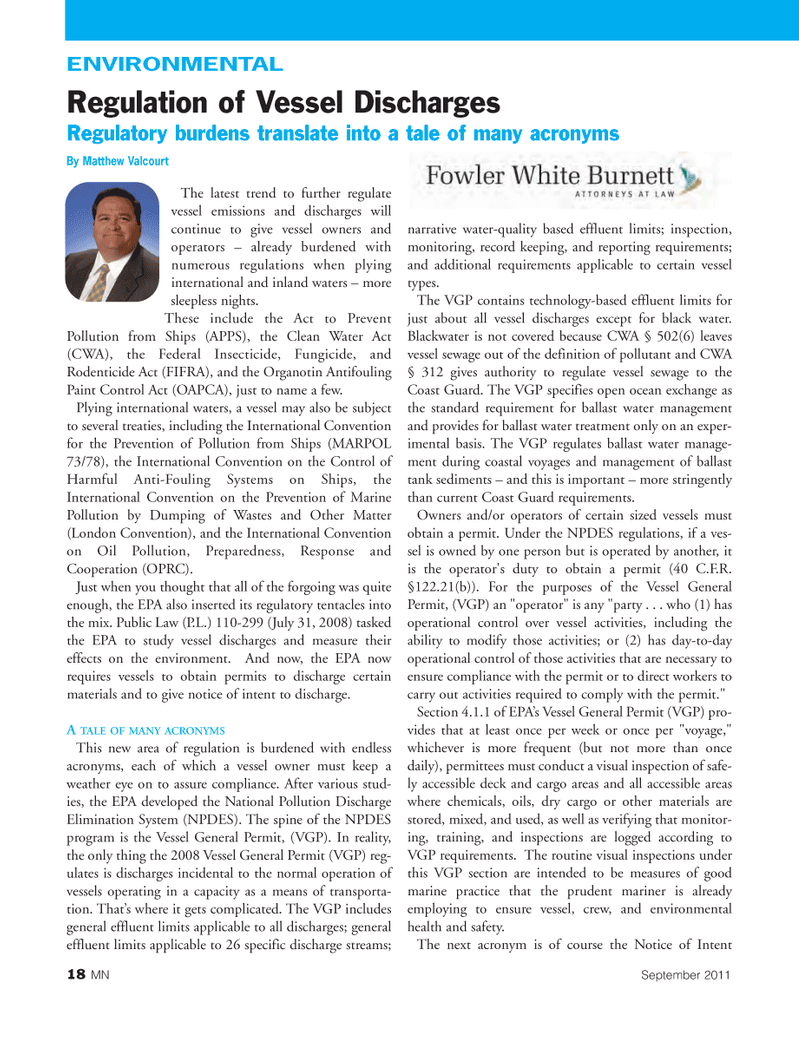
Page 18: of Marine News Magazine (September 2011)
The Environmental Edition
Read this page in Pdf, Flash or Html5 edition of September 2011 Marine News Magazine
18MNSeptember 2011ENVIRONMENTAL The latest trend to further regulate vessel emissions and discharges will continue to give vessel owners and operators ? already burdened with numerous regulations when plying international and inland waters ? more sleepless nights. These include the Act to Prevent Pollution from Ships (APPS), the Clean Water Act (CWA), the Federal Insecticide, Fungicide, and Rodenticide Act (FIFRA), and the Organotin Antifouling Paint Control Act (OAPCA), just to name a few. Plying international waters, a vessel may also be subject to several treaties, including the International Convention for the Prevention of Pollution from Ships (MARPOL 73/78), the International Convention on the Control of Harmful Anti-Fouling Systems on Ships, the International Convention on the Prevention of Marine Pollution by Dumping of Wastes and Other Matter (London Convention), and the International Convention on Oil Pollution, Preparedness, Response and Cooperation (OPRC). Just when you thought that all of the forgoing was quite enough, the EPA also inserted its regulatory tentacles into the mix. Public Law (P.L.) 110-299 (July 31, 2008) tasked the EPA to study vessel discharges and measure their effects on the environment. And now, the EPA now requires vessels to obtain permits to discharge certain materials and to give notice of intent to discharge. A TALEOFMANYACRONYMS This new area of regulation is burdened with endless acronyms, each of which a vessel owner must keep a weather eye on to assure compliance. After various stud- ies, the EPA developed the National Pollution Discharge Elimination System (NPDES). The spine of the NPDES program is the Vessel General Permit, (VGP). In reality, the only thing the 2008 Vessel General Permit (VGP) reg- ulates is discharges incidental to the normal operation ofvessels operating in a capacity as a means of transporta- tion. That?s where it gets complicated. The VGP includes general effluent limits applicable to all discharges; generaleffluent limits applicable to 26 specific discharge streams; narrative water-quality based effluent limits; inspection, monitoring, record keeping, and reporting requirements; and additional requirements applicable to certain vessel types.The VGP contains technology-based effluent limits for just about all vessel discharges except for black water. Blackwater is not covered because CWA § 502(6) leaves vessel sewage out of the definition of pollutant and CWA § 312 gives authority to regulate vessel sewage to the Coast Guard. The VGP specifies open ocean exchange as the standard requirement for ballast water management and provides for ballast water treatment only on an exper- imental basis. The VGP regulates ballast water manage- ment during coastal voyages and management of ballast tank sediments ? and this is important ? more stringently than current Coast Guard requirements. Owners and/or operators of certain sized vessels must obtain a permit. Under the NPDES regulations, if a ves- sel is owned by one person but is operated by another, it is the operator's duty to obtain a permit (40 C.F.R. §122.21(b)). For the purposes of the Vessel General Permit, (VGP) an "operator" is any "party . . . who (1) has operational control over vessel activities, including the ability to modify those activities; or (2) has day-to-dayoperational control of those activities that are necessary to ensure compliance with the permit or to direct workers to carry out activities required to comply with the permit." Section 4.1.1 of EPA?s Vessel General Permit (VGP) pro- vides that at least once per week or once per "voyage," whichever is more frequent (but not more than once daily), permittees must conduct a visual inspection of safe-ly accessible deck and cargo areas and all accessible areas where chemicals, oils, dry cargo or other materials are stored, mixed, and used, as well as verifying that monitor- ing, training, and inspections are logged according to VGP requirements. The routine visual inspections under this VGP section are intended to be measures of good marine practice that the prudent mariner is already employing to ensure vessel, crew, and environmental health and safety. The next acronym is of course the Notice of Intent By Matthew Valcourt Regulation of Vessel Discharges Regulatory burdens translate into a tale of many acronyms MN#9 (18-31):MN 2011 Layouts 9/6/2011 4:14 PM Page 18

 17
17

 19
19
